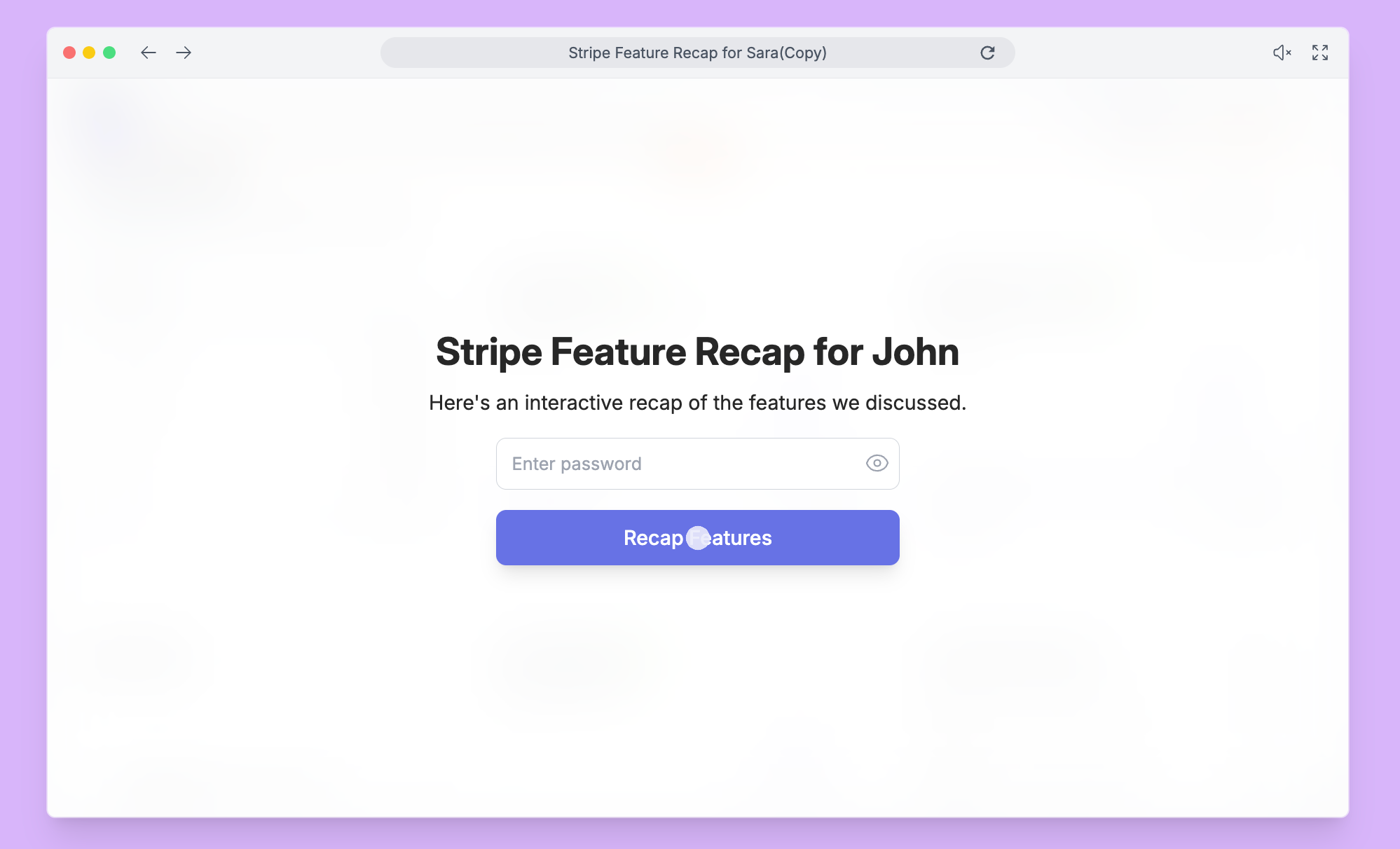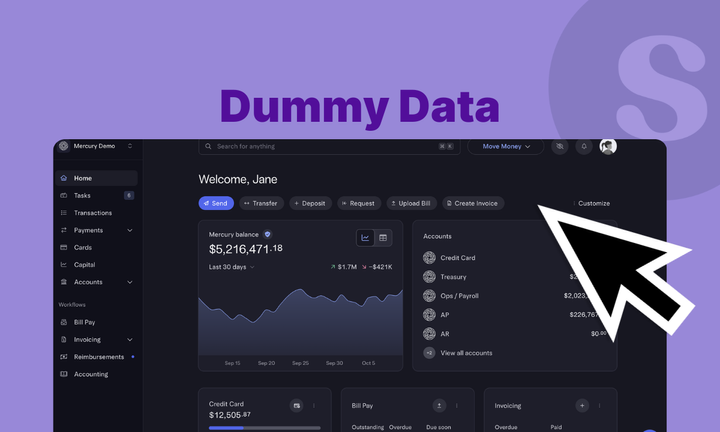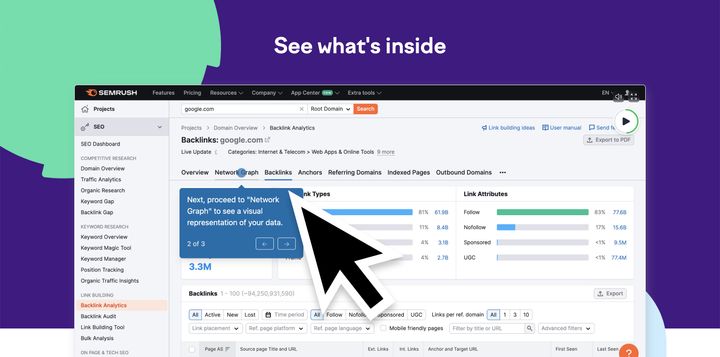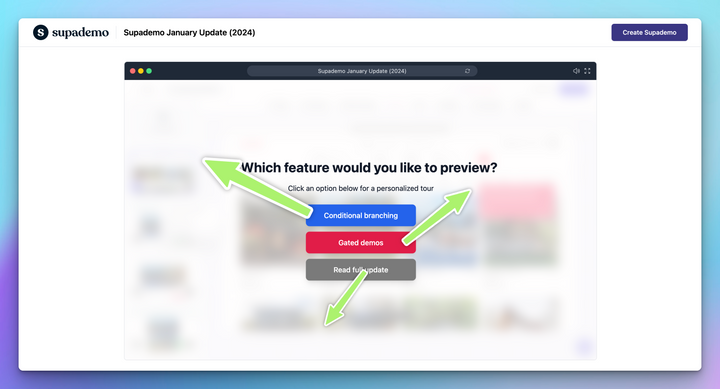Your prospect books a demo, eager to see how your product solves their problem. You deliver the pitch, walk them through the features, and highlight the value. Everything seems to land.
Afterward, though, they say they didn’t fully connect with the solution. Their objection isn’t about the product itself but about how it fits: “How would this handle our edge cases, our workflows, or our current tech stack?”
The issue often isn’t the explanation. It’s the lack of context. Empty dashboards and generic fields make it hard for prospects to picture real outcomes.
This is where dummy data comes into play.
In this blog, we’ll explore how dummy data transforms demos and product tours into experiences that feel real, relatable, and tailored to the buyer.
TL;DR
→It helps buyers visualize real scenarios, reducing the cognitive load and making your product easier to connect with.
→Benefits include smoother sales calls, consistent messaging, reduced risk, and richer product storytelling.
→Common mistakes: generic placeholders, missing context, poor alignment, privacy risks, and stale data.
→Best practices: mirror real workflows, diversify records, include edge cases, keep it safe, refresh often.
→ Tools like Supademo make this process faster and safer by auto-populating interactive demos with editable dummy data, removing the need for staging environments.
What is dummy data?
Dummy data, or fake data, is artificially generated information that mimics the structure and appearance of real-world data without containing any sensitive values. Its purpose is simple: to make your product feel alive and relatable so prospects can instantly see themselves using it.
For example, in an HR software demo, it’s far more effective to show a directory filled with employees like “Aisha Patel – Marketing Manager – New York” and “James Lee – Software Engineer – Toronto” than blank profiles or “User123.” By adding this context, dummy data transforms a static demo into a believable workflow that prospects immediately connect with.

Why is dummy data important?
Now that we’ve defined what dummy data is, the next question is why it matters. After all, a demo can technically run without it.
But the difference between an empty product and one filled with realistic, relatable data is the difference between showing features and telling a story.
- Buyer psychology: Empty dashboards force prospects to imagine how your product fits their world. Dummy data removes that “imagination tax” by showing realistic outcomes immediately, making it easier for buyers to connect and think, “this looks like us.”
- Sales efficiency: Preloading dummy data prevents reps from fumbling with blank fields or typing “Sample Co.” during a call. It keeps demos smooth, builds confidence, and shortens sales cycles by getting to value faster.
- Organizational scale: Your product story shows up in sales calls, websites, training, and onboarding. Dummy data keeps it consistent everywhere, reinforcing your message and avoiding conflicting product experiences.
- Risk management: Real customer data in demos creates privacy and compliance risks. Dummy data removes those risks while still looking authentic, letting you present confidently without exposure concerns.
- Product narrative: Features like forecasting, segmentation, and trend analysis only shine with rich datasets. Dummy data provides the depth needed to showcase advanced capabilities and highlight what sets your product apart.
5 Common dummy data mistakes
Dummy data can make demos far more engaging, but not all implementations deliver the right impact. When it’s poorly designed or misused, it can undermine credibility and weaken your product story. Here are some of the most common mistakes to watch for:

1. Generic placeholders
Seeing “John Doe” or “Acme Corp” in a demo instantly feels fake. Prospects notice when placeholders look lazy, and it breaks the illusion of realism. Instead of connecting with the product, they tune out because the demo feels unfinished.
2. Missing context
Random numbers or filler text don’t tell a story. If an analytics dashboard just shows “12345” without trends or labels, prospects are left guessing what it means. Dummy data should add meaning, not force the buyer to imagine outcomes.
3. Poor alignment with audience needs
A prospect in healthcare doesn’t care about fake e-commerce transactions. If the dummy data doesn’t match the buyer’s industry, role, or workflows, the demo feels generic instead of tailored. Misaligned data makes the product harder to relate to.
4. Privacy risks
Some teams mistakenly use real or poorly anonymized customer data in demos. This creates compliance risks and undermines trust. The whole point of dummy data is safety, so any slip in separating it from production data defeats the purpose.
5. Stale repetition
Using the same dummy dataset across every demo or website tour makes the experience predictable. If a prospect sees the same names and examples twice, the product starts to feel canned. Fresh, varied data keeps demos engaging and credible.
Best practices for creating dummy data
Dummy data only works when it feels believable. If it looks fake, repetitive, or unsafe, it will distract prospects instead of helping them. Here’s how you can build dummy data that makes your sales demos feel authentic.
1. Mirror real workflows
Your sales demo should reflect your prospect’s daily workflows. If you are showing a project management tool, personalize your sales demo so it displays tasks with owners, deadlines, and statuses in motion—not generic placeholders like “Task 1” or “Task 2.”
When the data matches how work actually gets done, prospects can follow the story naturally.
2. Prioritize security and privacy
Never use customer records, even if they are partially anonymized. A training demo seeded with masked emails can still create compliance issues. Generate your datasets from scratch so you get realism without risk.
3. Create diverse datasets
One type of record won’t show the full picture. A CRM demo with only mid-sized deals feels flat. Mix in different account types, deal sizes, and regions so prospects see how the product flexes across scenarios. Variety makes your product feel more robust.
4. Include edge cases
Your buyers know things don’t always go smoothly. Show how your product handles less-than-ideal situations. For example, include overdue invoices in a finance tool or inactive users in an HR directory. These small details make demos more convincing and reassure prospects that you can handle real-world complexity.
5. Balance detail and clarity
Too little data makes the product feel empty. Too much buries the point you are trying to highlight. Aim for just enough to keep dashboards and records alive without overwhelming the viewer. Think about what helps your story land, not what clutters the screen.
6. Separate it from production
Keep dummy data in a dedicated sales demo environment. Mixing it with production risks, confusion, privacy violations, and broken workflows. A clean separation lets you refresh data easily and keep your demo environments safe.
7. Update data regularly
Even the best dataset grows stale. If a prospect sees the same examples across multiple demos, it starts to feel scripted. Refreshing your dummy data keeps the experience engaging and signals that your product is active and well-maintained.
Good vs. bad demo data examples
What are the challenges in adding dummy data?
Adding dummy data sounds simple, but at scale, it becomes a bottleneck. Most teams need multiple demo environments for sales, training, and onboarding, and keeping them realistic is harder than it looks. Common challenges include:
- Complex data structures: modern products rely on linked records, relationships, and workflows that are tough to replicate with fake data.
- High volume needed: a handful of records isn’t enough—dashboards and pipelines need depth and variety to look alive.
- Multiple environments: maintaining consistent dummy data across dozens of demo instances quickly becomes overwhelming.
- Ongoing upkeep: data becomes stale quickly, and outdated metrics or repetitive examples can make demos feel canned.
Top 5 tools to create demo data
Seeding dummy data manually wastes time and breaks consistency. The following five tools help you automate realistic records and deliver demos that always look alive.
1. Supademo
Supademo is an AI-powered interactive demo platform that lets you build high-fidelity demos effortlessly.
Instead of juggling multiple tools or manually populating demo instances, you can record your product once and instantly generate a guided HTML demo or sandbox demo. Both options come preloaded with editable dummy data, so every demo looks polished, consistent, and safe to share.
Key features:
- High-fidelity demos: Supademo captures your product’s HTML and CSS to create pixel-perfect replicas. Prospects can click, scroll, and type as if they were in your live app, without the risks of exposing production data.
- Easy editing: After recording, you can swap out names, images, or logos with a few clicks using our intuitive editor. That means one demo can be quickly tailored to a specific industry, region, or persona instead of rebuilding from scratch.
- Data redaction: Sensitive details like customer names, account numbers, or billing information can be blurred or hidden instantly. You don’t have to worry about compliance risks while maintaining believable demos.
- AI voiceovers and annotations: You can add AI-generated voice-overs and texts to hotspots in 15 languages. This makes demos useful not just for sales calls but also for global marketing campaigns and self-serve product tours.
- Bulk text replace: If you need to change a company name or product term across dozens of screens, Supademo lets you do it in one step. This keeps your content consistent and saves hours of manual editing.
- Demo analytics: You can see where prospects click, how long they spend on each step, and what captures their attention, giving your team insight into what resonates before the next call.
Pros:
- Cuts demo prep from hours to minutes by removing the need to set up staging environments or seed dummy data manually
- Makes personalization easy so every demo can be tailored to an industry, persona, or prospect without rebuilding from scratch
- Eliminates demo risks by replacing fragile live environments with safe dummy data that keeps customer information protected
- Easy to use for non-technical teams to create polished, interactive demos without depending on engineering
With this feature, users can automatically personalize data across interactive demos using AI or simple randomization algorithms. This feature lets you tailor content—such as names, numbers, or scenario details—for specific industries, personas, ideal customer profiles (ICPs), or use cases instantly, without manual editing or re-recording.
Cons:
- Capture may be slower on media-heavy pages with lots of video or animations
Should you use it?
Yes, if you want to give your sales team the power to create realistic, interactive demos quickly and safely. Supademo is ideal for anyone looking to avoid the complexity of managing dummy data across multiple tools.
2. Faker
Faker is a Python library that generates diverse, realistic fake data, including names, addresses, emails, and other personal information, while maintaining privacy and compliance standards.
Key features
- Comprehensive data types: Personal information, business data, internet/technology data, geographic coordinates, and financial information
- Localization support: Multiple locales for region-specific data formats (phone numbers, addresses, names)
- Bulk data generation: Efficiently create thousands of records programmatically
- Custom providers: Extensible architecture for domain-specific data types
Pros
- Open-source with active community support and regular updates
- Extremely versatile with 200+ data types available
- Lightweight with minimal dependencies and easy integration
Cons
- Requires Python programming knowledge
- Limited graphical interface (primarily code-based)
- Not suitable for non-technical users
Should you use Faker?
Yes, if you're a developer or data scientist who needs programmatic control over test data generation and can work with Python. Perfect for automated testing, database seeding, and data analysis scenarios.
3. Mockaroo
Mockaroo is a versatile web-based platform that generates realistic test data through an intuitive spreadsheet-like interface, supporting various output formats including CSV, JSON, SQL, and Excel.
Key features
- Schema builder: Easy-to-use web interface resembling a spreadsheet for defining data structures
- 200+ data types: Names, emails, addresses, credit card numbers, and specialized data fields
- Multiple export formats: CSV, JSON, SQL, Excel, and other common formats
- Bulk generation: Up to 1,000 rows free, up to 10 million with premium plans
Pros
- No programming knowledge required - completely web-based
- User-friendly interface that's intuitive for all skill levels
- Generates high-quality, realistic data that closely mimics real-world patterns
Cons
- No built-in data masking capabilities
- Not optimized for very large-scale enterprise projects
- Advanced features require a paid subscription
Should you use Mockaroo?
Yes, if you need realistic test data quickly without programming, and your requirements fit within the row limits. Ideal for QA teams, business analysts, and developers who prefer web-based tools.
4. RandomUser.me
RandomUser.me is a free, open-source API that generates realistic user profiles for testing, prototyping, and demo environments. You can request names, emails, locations, profile photos, and other metadata in formats like JSON, CSV, XML, or YAML.
Key Features
- Complete user profiles: Photos, names, emails, birth dates, addresses, phone numbers, and passwords
- API-based access: Simple GET requests with JSON, XML, CSV, and YAML output formats
- Bulk generation: Generate up to 5,000 users in a single API call
- Field customization: Include or exclude specific data fields from responses
Pros
- Completely free with no signup required
- High-quality user photos that look authentic
- Simple API that works with any programming language
Cons
- Limited to user/person data only - not suitable for other data types
- Cannot generate custom data types beyond user profiles
- API rate limits may apply for very high-volume usage
Should you use RandomUser.me?
Yes, if you're developing user-centric applications, social platforms, or any interface that displays user profiles. Perfect for frontend developers, UI/UX designers, and anyone needing realistic user data with photos.
5. Generatedata.com
Generatedata is an open-source web-based tool written in PHP, JavaScript, and MySQL that provides customizable test data generation with support for multiple formats and data types.
Key features
- Open-source flexibility: Full source code access for customization and self-hosting
- Multiple export formats: CSV, JSON, XML, SQL, and Excel support
- Customizable data types: Ability to modify and create new data generators
- Self-hosting option: Install on your own servers for complete control
Pros
- Completely free and open-source
- Can generate up to 100 records at once in the free version
- No vendor lock-in - full control over the tool
Cons
- No built-in data masking capabilities
- Limited data types in the free version
- Self-hosting requires a PHP and MySQL setup
Should you use Generatedata.com?
Yes, if you need an open-source solution with full customization control and don't mind technical setup. Ideal for organizations with specific data generation requirements or those preferring self-hosted solutions.
What are the use cases of dummy data?
Dummy data isn’t limited to testing environments. It has a wide range of practical applications across the product lifecycle, from sales to support. Here are the most common scenarios:
1. Demo leave-behinds
After a sales call, your prospect will often ask, “Can we share this internally?” Instead of sending a static deck, you can leave them with a clickable demo preloaded with dummy data.
That way, a sales VP can walk their team through a pipeline that looks real while keeping actual customer information safe.
2. Live demos
Nothing kills momentum faster than an empty dashboard. With dummy data, you can open a CRM that already shows this quarter’s deals by stage and rep or an analytics tool charting campaign performance. You avoid saying, “imagine your data here.” Instead, you show a working scenario that feels authentic.
3. Proof of concepts (POCs)
POCs often drag on while everyone waits for integrations. With dummy data, you can spin up a working environment right away. If you are demoing a marketing automation tool, you could preload it with campaigns, email sequences, and performance metrics so the buyer sees value on day one.
4. Internal training
New hires need hands-on practice, but giving them access to production is risky. With dummy datasets, you can train reps in a safe space. An SDR can practice logging calls and updating deals, while a support agent can resolve mock tickets like “failed login” or “billing error” without touching live accounts.
5. Customer education
When you are onboarding customers, showing is always better than telling. Instead of blank fields or fake “User123” profiles, you can guide them through adding employees, approving time-off, or running payroll with realistic dummy data. It is easier for them to follow along and less risky for you.
6. Onboarding and playbooks
Blank screens confuse new users. By preloading dashboards, reports, or workflows with dummy data, you give them a clear starting point. For example, if you run a finance platform, you could show expense categories, monthly revenue trends, and forecasts right away so they see the value before uploading their own data.
Turning demos into stories with dummy data
The toughest part of a demo is not showing features but helping buyers see themselves in your product. Dummy data closes that gap by replacing empty dashboards with believable records and workflows. Instead of asking prospects to imagine, you show them what their world could look like.
Supademo makes this process effortless, letting you capture your product once, auto-fill it with editable data, and deliver demos that feel authentic every time.
👉 Try Supademo today and start delivering demos your prospects actually connect with.
FAQs
Can ChatGPT create dummy data?
ChatGPT can generate basic sample records, but for sales demos, internal training, customer onboarding, Supademo is better. It auto-fills interactive demos with editable dummy data, removing the need for staging environments or manual setup.
Who is responsible for creating dummy data?
Who is responsible for incorporating dummy data into demo environments?
Dummy data is usually prepared by sales engineers, product managers, or demo specialists. They curate realistic records that showcase product workflows effectively while ensuring no sensitive or confidential customer information is exposed.
What are the characteristics of good dummy data?
Good dummy data looks realistic, mirrors actual workflows, includes variety, stays free of sensitive information, and is updated regularly so demos feel current instead of canned.
How can you generate dummy data for demos?
You can generate dummy data manually by creating records, use open-source libraries like Faker, leverage platforms like Mockaroo, or adopt tools like Supademo that auto-populate interactive demos with editable data.
What is the best tool for generating dummy data for demos?
Supademo is one of the best choices for generating dummy data. You can record your product once, auto-populate it with realistic dummy data, customize names or logos, redact sensitive info, and share polished interactive demos instantly without needing engineering or staging environments.
What is dummy data for description?
Dummy data for description refers to placeholder information such as names, emails, numbers, or records used to illustrate how fields and workflows look in a demo. It shows structure and context without exposing real customer data.




